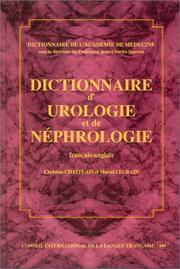| Listing 1 - 2 of 2 |
Sort by
|

ISBN: 285319289X 9782853192897 Year: 2001 Publisher: Paris : Conseil International de la Langue Française (CILF),
Abstract | Keywords | Export | Availability | Bookmark
 Loading...
Loading...Choose an application
- Reference Manager
- EndNote
- RefWorks (Direct export to RefWorks)
Urology --- French language --- Nephrology --- Urologie --- Français (Langue) --- Néphrologie --- Dictionaries --- French --- English --- Dictionary --- Dictionnaires français --- Dictionnaires anglais --- Dictionaries, Medical --- Nierziekten --- Ziekten van de geslachtsorganen --- Ziekten van de urinewegen --- woordenboeken --- woordenboeken. --- Woordenboeken. --- Français (Langue) --- Néphrologie --- Dictionnaires français --- French. --- Urology - dictionary --- Nephrology - dictionary
Book
Year: 2001 Publisher: Bruxelles: UCL,
Abstract | Keywords | Export | Availability | Bookmark
 Loading...
Loading...Choose an application
- Reference Manager
- EndNote
- RefWorks (Direct export to RefWorks)
In clinical practice, the use of platelet transfusion has increases progressively. A common complication is platelet alloimmunization, a major cause for refractoriness to repeated platelet transfusions. Therefore several attempts mere made to produce autologous platelets in-vitro to prevent this complication.
In this study, we were able to produce platelets in-vitro from cultured human peripheral blood stem cells (DC34+) in liquid culture medium that promotes megakaryocytopoiesis and thrombocytopoiesis.
Cells in culture did show a high proliferative capacity throughout the culture days, with megakaryocytic proliferation and differenciation, in the presence of growth factors that stimulate megakaryocytopoiesis and thrombocytopoiesis (rh-TPO, rh-IL-3, rh-IL-6, and rh-IL-11).
The megakaryocytic cells were identified by flow cytometry as CD61+ cells with scatter properties of nucleated cells, by morphology, by immunocytochemistry. MKs were first observed in culture medium from 7 days, many of them releasing proplatelets. They reached a peak on day 14. Thereafter cells disappeared from the culture medium. Most of the MKs did not show a ploidy of more than 4N by our measurement methodology and only a very few proportion of them reached 8N.
Culture-derived were detected as CD41+ events and shared the same scatter properties of normal blood platelets in flow cytometry. Although they are successfully produced in culture, they seem to be somewhat activated since expression of P-selectin (GMP 140; CD62+) detected by flow cytometry, a finding that makes their clinical use still questionable. They appeared from day 7 and reached a peak on day 14.
In summary, we settled a technology for producing platelets in in-vitro culture. These platelets show characteristics of normal platelets; however, more experiments are required in order to improve their rate of production and to obtain a normal function
| Listing 1 - 2 of 2 |
Sort by
|

 Search
Search Feedback
Feedback About
About Help
Help News
News